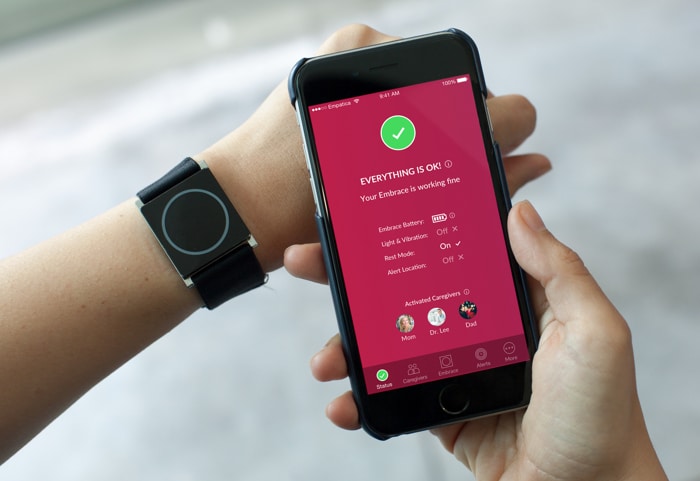A Conversation with Rosalind Picard
Natasha’s Mum had been in the shower when she heard her phone issue an alarm indicating her daughter might need help. She ran out of the shower to her daughter’s room where she saw her lying face down on her bed, her face blue. Realising that her daughter had just had a seizure, her Mum flipped her over. The mere act of repositioning her triggered her to start breathing again and the colour slowly returned to her face.
What had saved her daughter’s life was the Embrace smartwatch, which identifies convulsive seizures in epileptics and alerts caregivers through a complementary app. The technology is developed by the team at Empatica, a company co-founded by Rosalind Picard, Director of Affective Computing Research Group at the MIT Media Lab.
In essence, Embrace works by monitoring subtle electrical changes across the surface of the skin, together with convulsive movements. Rosalind explains, “To measure electrical changes in the skin, we pass a little current through and log how the voltage changes. As the neurological system inside your brain engages in anxiety or fear, the sweat glands under the surface of your skin start to fill. Some seizures can also trigger this brain-to-skin cascade of responses.
“This causes the electrical conductance across the surface of your skin to actually change, even when you don’t feel any difference on the surface of your skin. Peaks and valleys can be tracked in real-time and displayed on a graph. When the data peaks, for example, it’s usually an indication that the person is experiencing heightened arousal — like the type you might experience rushing to get ready for work in the morning, while riding a rollercoaster, or during the onset of a seizure.”

Pictured: Empatica’s Embrace2 Smartwatch paired with the company’s Alert App. Source: Empatica
Rosalind had first learned about Natasha’s life being saved by Embrace after receiving an email from her Mum. Rosalind shares, “It’s been a bit scary learning of the serious need in the world, and the potential for seizures to turn off breathing and cause death, particularly in people who are alone when a serious seizure hits. I was previously used to making mostly amusing things that run on a computer. Now, all of a sudden, our work is out there helping people save lives by getting to their loved one’s aid more quickly.”
The origin of Embrace
It isn’t hard to see why Rosalind has been shaken by some of the emails she has received. She never set out to create wearable technology that would save lives. With doctorate degrees in electrical engineering and computer science from MIT, her work initially focused on modelling computers after people — i.e. computers with perceptual and intellectual capabilities. It was through that work that she discovered just how important emotions are to human intelligence.
In spite of what she learned, Rosalind wasn’t really interested in doing work related to emotions. She did, however, want to encourage others in the field, so she wrote a book on the subject called Affective Computing. One of the main thrusts of the book is that if we want computers to interact naturally with us, we have to give them the ability to recognise, understand and express emotions.
The book sparked greater interest in the field leading to Rosalind and her students inventing methods to understand emotions better. In the course of that work, they discovered that by measuring skin conductance, along with other activity in the body, they could better detect certain neurological events like seizures.
With that discovery, she and her team developed the Embrace smartwatch, the first FDA-cleared smartwatch for monitoring epileptic seizures. Rosalind also co-founded the start-up, Empatica, that builds the Embrace wearable and other similar devices.
Measuring skin conductance on the wrist has led to a number of surprises. In some cases, the brain activity can have this huge surge that causes a large skin conductance surge even when the EEG shows nothing, because if the brain activity is deep and it doesn’t reach the scalp, the EEG looks flat.
“The epilepsy doctors may see no signs of epilepsy [based on an EEG] but we can see a response in some cases that is very significant on the wrist. So, it becomes another important thing to measure besides the scalp. The skin, the epidermis, that is connected from the moment we are embryos to our neural tissue, our spinal cord, has a lot more patterned information in it than we ever expected to find,” she says.
What Embrace could mean for SUDEP
One area where Embrace may be particularly life-altering is in helping those individuals at risk of SUDEP (Sudden Unexpected Death in Epilepsy). While few people have heard of it, the prevalence of SUDEP is especially alarming.
For instance, Rosalind says, “SUDEP is taking more lives than Sudden Infant Death Syndrome (SIDS) and house fires. It’s number two of all neurological disorders after stroke in robbing people of years of reduced life expectancy — more than multiple sclerosis, ALS, Parkinsons or Alzheimers.”

Above: The years of potential life lost caused by neurological disorders. Source: Thurman DJ
Above: Rosalind’s 2018 TEDx talk, which explains more about SUDEP. Source: TED
SUDEP is when an otherwise healthy person with epilepsy dies and we can’t attribute it to anything we find in an autopsy. There is a SUDEP death every 7 to 9 minutes.
While there isn’t a single cause that explains all SUDEP deaths, there’s clinical evidence of oxygen deprivation in both convulsive and non-convulsive seizures. As the non-profit SUDEP Action reports, “Some individuals may experience prolonged cerebral suppression following a seizure, which may be associated with central apnea leading to cardiac arrest.”
This is a scenario that Rosalind is working hard to put a stop to. As she explains it, “SUDEP is likely preventable. It’s been shown that if you were willing to let someone drill a hole in your skull and go in and stick a needle in your amygdala and electrically stimulate it, that you would just stop breathing and start turning blue in front of me.
“And you wouldn’t show any signs of pain or distress. In fact, you might still be listening to me just fine, you’re just not breathing until we say, ‘Mike! Mike! Are you okay?’ or somebody walks in and then touches you, and then you go ‘What?’ and you take a breath.”
That’s why Embrace has such vast potential to help those who suffer from seizures. Should they stop breathing in the midst of a seizure, a caregiver has the opportunity to turn them on their side or touch them or say their name and ask if they’re okay. That may be enough to restart their breathing.
In this sense, Embrace has the potential to save an enormous amount of lives because most epileptic seizures that end in death occur when people are alone and their seizure goes unnoticed by a caregiver.
Freedom to live
Beyond saving lives, Embrace can be credited as enabling users to experience more fulfilling lives too. Kurt Eichenwald, a Pulitzer Prize-nominated New York Times bestselling author who suffers from epilepsy and uses Embrace, recently shared at the American Epilepsy Society’s Annual Meeting how the technology is helping him overcome fear so he can live a fuller life.
Kurt Eichenwald shares, “One of the biggest problems with epilepsy is fear and living with it every day. The trouble with fear is that you have to overcome it to be independent and not everyone can. [Embrace] is a huge step in helping people combat the fear. You know you won’t disappear. You know that if you fall somewhere in the street and you’re by yourself, you will be found.”
Eichenwald went on to explain, “That is a massive step forward in helping people with epilepsy get liberated. In the end, even if you can’t get your seizures controlled, you can defeat epilepsy by living a full life”.
Eichenwald has even written a book about his torturous battle with epilepsy. Titled, A Mind Unraveled: A Memoir, the book provides a deeply candid account of the painstaking years he spent trying to keep his condition a secret to avoid discrimination, and his ensuing decades-long battle to not only survive, but to thrive.
To think that technology like Embrace can provide people like Kurt Eichenwald with a life worth living — and even go as far as to save the lives of people like Natasha — marks a turning point for providing better support to those suffering from epilepsy.
For more information on Embrace visit www.empatica.com.



